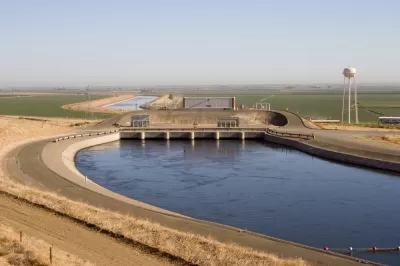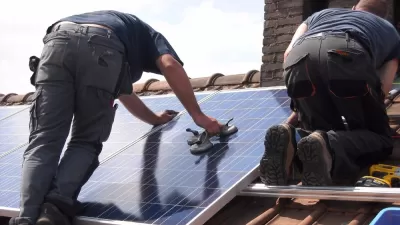Research claims that installing solar panels over California's extensive canals could greatly expand the state's renewable energy production and reduce evaporation.

A new study published in Nature Sustainability outlines the potential benefits of covering California's canals with solar panels, reports Matt Simon in High Country News. The study's results show that installing solar panels over 4,000 miles of California's waterways "would save 63 billion gallons of water from evaporating each year" and "provide 13 gigawatts of renewable power annually, about half of the new capacity the state needs to meet its decarbonization goals by the year 2030."
Doubling up on uses for the canals would provide a convenient solution for solar installations that would otherwise require the disturbance of natural habitats or farmland. Michael Kiparsky, director of the Wheeler Water Institute at the UC Berkeley School of Law, likens the idea to placing rooftop solar panels on a suburban home. "You’re taking something that's already been altered by human activity and doubling up on the benefits it provides."
Environmental engineer Brandi McKuin, lead author on the paper, said that "by covering canals with solar panels, we can reduce evaporation and avoid disturbing natural and working lands, while providing renewable energy and other co-benefits." The study's authors "also took into account the human benefits of such a project, which are more nebulous. For example, many farmers pump their water with diesel generators. If solar panels provided that energy instead, that could cut local emissions, thus improving air quality."
"Solar-paneling California’s canals could also prepare the state for the widespread adoption of electric cars. The California Aqueduct runs right along Interstate 5, the major artery carrying traffic between the northern and southern halves of the state. Where there are now gas stations dotted along the way, in the future there might be car-charging stations that draw power from the nearby aqueduct."
The study's authors recommend a demonstration project to evaluate the costs, benefits, and potential challenges associated with a full-scale implementation of the concept.
FULL STORY: Study looks at covering California’s canals with solar panels

Maui's Vacation Rental Debate Turns Ugly
Verbal attacks, misinformation campaigns and fistfights plague a high-stakes debate to convert thousands of vacation rentals into long-term housing.

Planetizen Federal Action Tracker
A weekly monitor of how Trump’s orders and actions are impacting planners and planning in America.

San Francisco Suspends Traffic Calming Amidst Record Deaths
Citing “a challenging fiscal landscape,” the city will cease the program on the heels of 42 traffic deaths, including 24 pedestrians.

In U.S., Urban Gondolas Face Uphill Battle
Cities in Latin America and Europe have embraced aerial transitways — AKA gondolas — as sustainable, convenient urban transport, especially in tricky geographies. American cities have yet to catch up.

Detroit Says Problems With Property Tax Assessments are Fixed. Advocates Disagree.
With higher-valued properties under assessed and lower-valued properties over assessed, advocates say there's still a problem with Detroit's property tax system.

Defunct Pittsburgh Power Plant to Become Residential Tower
A decommissioned steam heat plant will be redeveloped into almost 100 affordable housing units.
Urban Design for Planners 1: Software Tools
This six-course series explores essential urban design concepts using open source software and equips planners with the tools they need to participate fully in the urban design process.
Planning for Universal Design
Learn the tools for implementing Universal Design in planning regulations.
Heyer Gruel & Associates PA
JM Goldson LLC
Custer County Colorado
City of Camden Redevelopment Agency
City of Astoria
Transportation Research & Education Center (TREC) at Portland State University
Jefferson Parish Government
Camden Redevelopment Agency
City of Claremont





























